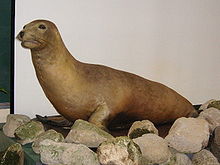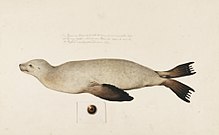Japanese Sea Lion
Taxonomy

Prior to 2003, it was considered to be a subspecies of California sea lion as Zalophus californianus japonicus. However, it was subsequently reclassified as a separate species. DNA analysis in 2007 estimated that the divergence point between the two sea lions took place around 2 million years ago (mya) in the early Pleistocene.
Several taxidermied specimens can be found in Japan and in the National Museum of Natural History, Leiden, the Netherlands, bought by Philipp Franz von Siebold. The British Museum possesses a pelt and four skull specimens.
Description

Male Japanese sea lions were dark grey, reaching lengths of 2.3 to 2.5 metres (7.5 to 8.2 ft) and weighed about 450 to 560 kilograms (990 to 1,230 lb). Females were significantly smaller at 1.64 to 1.8 metres (5.4 to 5.9 ft) long and weighed about 120 kilograms (260 lb) with a lighter grey colour than the males.
Distribution and habitat
Japanese sea lions were found along the northwest Pacific coastline, specifically in Japan, Korea, southern Kamchatka Peninsula, and the Sakhalin Island. However, they may not have existed in Kamchatka, with their northernmost range extending only to the Kuril Islands. Sightings of individual Japanese sea lions still persist in Korea, but these are probably misidentified Steller's sea lions (Eumetopias jubatus). The only reliable report from Kamchatka may have been of a single individual shot at Moneron Island in 1949.
Old Korean accounts also describe that the sea lion and spotted seal (Phoca largha) were found in a broad area containing the BoHai Sea, the Yellow Sea, and the Sea of Japan. Many places along the Japanese coastline are named after sea lions or seals, such as Ashika-iwa (海驢岩 or 海鹿岩, sea lion rock) , Ashika-jima (海獺島 or 海鹿島, sea lion island), and Cape Inubō (犬吠埼, dog-barking point). Bones of Z. japonicus dating to 3500–2000 BC were found in the Shell Mound in Dongsam-dong, Busan. Genetic evidence confirms the former presence of Z. japonicus on the Liancourt rocks.

They usually resided on flat, open, and sandy beaches, but rarely in rocky areas. Their preference was to rest in caves.
Exploitation and extinction


Many bones of the Japanese sea lion have been excavated from shell middens from the Jōmon period in Japan. An 18th-century encyclopedia, Wakan Sansai Zue, describes that the meat was not tasty and they were only used to render oil for oil lamps. Valuable oil was extracted from the skin, its internal organs were used to make expensive medicine, and its whiskers and skin were used as pipe cleaners and leather goods, respectively. At the turn of the 20th century, they were captured for use in circuses.
Harvest records from Japanese commercial fishermen in the early 1900s show that as many as 3,200 sea lions were harvested at the turn of the century, and overhunting caused harvest numbers to fall drastically to 300 sea lions by 1915 and to a few dozen sea lions by the 1930s. Japanese commercial harvest of Japanese sea lions ended in the 1940s when the species became virtually extinct. In total, Japanese trawlers harvested as many as 16,500 sea lions, enough to cause their extinction. Submarine warfare during World War II is also believed to have contributed to their habitat destruction. The last population survey dates from the 1950's and reported a population of only 50 to 60 animals on the Liancourt Rocks. The most recent sightings of Z. japonicus are from the 1970s, with the last confirmed record being a juvenile specimen captured in 1974 off the coast of Rebun Island, northern Hokkaido. There were a few unconfirmed sightings in 1983 and 1985. In any case, it was one of the most recent marine mammal extinctions to occur, alongside the Caribbean monk seal which went extinct at around the same time.
Attempted rewilding
This section needs to be updated. The reason given is: Occurrences after 2010 are not verified in any of the currently cited sources. (January 2020) |
In 2007, the South Korean Ministry of Environment announced that South Korea, North Korea, Russia, and China will collaborate on bringing back sea lions to the Sea of Japan, starting with a search for any Japanese sea lions that might still be alive. The National Institute of Environmental Research of South Korea was commissioned to conduct feasibility research for this project. If the animal cannot be found, the South Korean government plans to relocate California sea lions from the United States. The South Korean Ministry of Environment supports the effort because of the symbolism, national concern, the restoration of the ecological system, and possible ecotourism.
Post-extinction claimed sightings or vagrant records
Sightings of single sea lions of unclear identities have been reported at Iwami, Tottori in July 2003, and on Koshikijima Islands in March 2016. Both animals were positively identified as Otariidae based on photographs, but their identities are unclear.
References
- ^ Lowry, L. (2017). "Zalophus japonicus". IUCN Red List of Threatened Species. 2017: e.T41667A113089431. doi:10.2305/IUCN.UK.2017-1.RLTS.T41667A113089431.en. Retrieved 12 November 2021.
- ^ Wilson, D. E.; Reeder, D. M., eds. (2005). Mammal Species of the World: A Taxonomic and Geographic Reference (3rd ed.). Johns Hopkins University Press. p. 668. ISBN 978-0-8018-8221-0. OCLC 62265494.
- ^ "울릉도에 강치 서식…현대과학으로 입증". 29 November 2020.
- ^ Sakahira, F.; Niimi, M. (2007). "Ancient DNA analysis of the Japanese sea lion (Zalophus californianus japonicus Peters, 1866): preliminary results using mitochondrial control-region sequences". Zoological Science. 24 (1): 81–85. doi:10.2108/zsj.24.81. PMID 17409720. S2CID 10824601.
- ^ (in Japanese) "天王寺動物園で「絶滅の危機にある動物展」を開催します" Archived 2007-11-26 at archive.today Tennoji Zoo, Osaka, Japan.
- ^ ニホンアシカ剥製標本 (in Japanese). Shimane University Museum. Archived from the original on 2015-12-22. Retrieved 22 August 2017.
- ^ "アザラシ目 アシカ科 絶滅危惧IA類(CR) (CR)" (in Japanese). Japan Integrated Biodiversity Information System. Archived from the original on 5 June 2011.
The Japanese sea lion (Zalophus californianus japonicus) was common in the past around the coast of the Japanese Archipelago, but declined rapidly after the 1930s from overhunting and increased competition with commercial fisheries. The last record in Japan was a juvenile, captured in 1974 off the coast of Rebun Island, northern Hokkaido.
- ^ Rice, D. W. (1998). Lawrence, K. S. (ed.). Marine Mammals of the World: Systematics and Distribution. Society for Marine Mammalogy. p. 231. ISBN 978-1-891276-03-3.
- ^ Duffield, D. A. (2008). "Extinctions, Specific". In F. Perrin, William; Würsig, Bernd; Thewissen, J. G. M. (eds.). Encyclopedia of Marine Mammals (2 ed.). Academic Press. pp. 80–89. ISBN 978-0-12-373553-9.
- ^ Tetsuro, Itoo; Akiyoshi, Fujita; Kin-ya, Kubo. "Pinniped records on the neighbouring waters of the Korean Peninsula: Japanese sea lions and larga seals recorded in the ancient literature of Korea". 野生生物保護 (in Japanese). 6 (2): 51–66. ISSN 1341-8777.
- ^ Choy, Kyungcheol; Richards, Michael P. (2010-02-02). "Isotopic evidence for diet in the Middle Chulmun period: a case study from the Tongsamdong shell midden, Korea". Archaeological and Anthropological Sciences. 2 (1): 1–10. Bibcode:2010ArAnS...2....1C. doi:10.1007/s12520-010-0022-3. ISSN 1866-9557. S2CID 131284557.
- ^ Lee, Sang-Rae; Kim, Yun-Bae; Lee, Tongsup (September 2019). "The First Molecular Evidence of Korean Zalophus japonicus (Otariidae: Sea Lions) from the Archaeological Site of Dokdo Island, Korea". Ocean Science Journal. 54 (3): 497–501. Bibcode:2019OSJ....54..497L. doi:10.1007/s12601-019-0019-5. ISSN 1738-5261. S2CID 201282948.
- ^ (in Japanese) Zalophus californianus japonicus (EX) Archived 2011-07-19 at the Wayback Machine, Shimane Red Data Book 2004, Shimane Prefecture, Japan.
- ^ The Jomon people in the northern Island Archived 2007-10-26 at the Wayback Machine, National Museum of Japanese History.
- ^ The Sannai Maruyama Site-Food Archived 2006-09-28 at the Wayback Machine, Aomori Prefecture, Japan, p. 7.
- ^ (in Japanese) (en abstract available) Michiko Niimi, Sea Mammal Hunting of the Jomon Culture in Hokkaido, Bulletin of the Department of Archaeology, 9 (19901228), 137–171, University of Tokyo ISSN 0287-3850
- ^ Terajima Ryōan, Wakan Sansai Zue (ca. 1712), vol. 38, Amimals, p. 72, sea lion and fur seal[1] "其肉亦不甘美 唯熬油為燈油 (the meat is not tasty and just used to render oil for oil lamps.)".
- ^ 일본어부에 의해 멸종당한 독도 강치 (in Korean). Dokdocenter.org. 2007-03-05. Retrieved 2007-09-20.
- ^ 독도에 바다사자 복원한다 (in Korean). The Kukmin Daily archived by Korea Coast Guard. 2006-02-02. Archived from the original on 2011-10-02. Retrieved 2008-07-18.
- ^ "Extinct Sea Lions to Bring Back to Korea". The Korea Times. 2007-09-05. Archived from the original on 2015-09-24. Retrieved 2015-08-12.
- ^ "Encyclopedia of Marine Mammals" (second ed.). Academic Press 2008. 2008. Retrieved 2011-05-23.
- ^ Ellis, R. (2003). The Empty Ocean. Island Press. p. 183. ISBN 978-1-55963-974-3.
- ^ Zalophus japonicus. The Extinction Website
- ^ (in Korean) "독도 바다사자(강치) 복원에 대한 조사 및 타당성 검토요청 (Request for Research on Feasibility of Reintroducing Dokdo Sea Lions)", South Korean Ministry of Environment, 2006-01-09.
- ^ "鳥取県岩美町でアシカ?目視". Archived from the original on 2013-01-05. Retrieved 2020-09-04.
- ^ "<1889>鹿児島県薩摩川内市で種不明アシカ出現". Archived from the original on 2016-06-02. Retrieved 2020-09-04.
- ^ 【動画】どこから来た?鹿児島近海でアシカ発見
External links
 Data related to Japanese sea lions at Wikispecies
Data related to Japanese sea lions at Wikispecies Media related to Japanese sea lions at Wikimedia Commons
Media related to Japanese sea lions at Wikimedia Commons